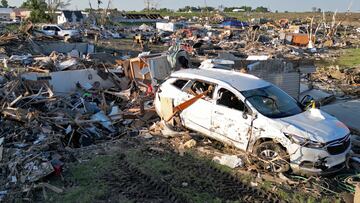The 5 biggest and most destructive tornadoes in US history
A look at the most destructive tornados that have touched down in the US and why so many occurred before 1900.


The United States is amid tornado season, which has proved particularly destructive this year. Across the country, these violent storms have claimed the lives of twenty-one people, with the threat of tornados still highly active through July in some areas.
Tornados, like hurricanes, have a rating system that meteorologists use to determine a storm’s strength.
How is the strength of a tornado measured?
Tornados, like hurricanes, have a rating system that meteorologists use to determine a storm’s strength. The Enhanced Fujita Scale, EF scale for short, has been used by the National Weather Service since 2007 and issues a rating for the storm based on its wind and related damage. The EF scale is different from those that rate hurricanes, as it is determined after the storm because of the chaotic nature of tornados. Their strength, behavior, and potential for damage are difficult to predict, meaning when a tornado warning or alert is issued, those under it should listen to the advice because the risk is imminent.
The EF system replaced a previous version that looked only at wind gusts.
Wind Gusts and the Enhanced Fujita Scale
EF Rating | 3 Second Gust (mph)
- Rating 0: 65 to 85
- Rating 1: 86 to 110
- Rating 2: 111 to 135
- Rating 3: 136 to 165
- Rating 4: 166 to 200
- Rating 5: Over 200
Source: National Weather Service
The enhanced version also considers damage by examining physical structures and their impact on nature, including schools, shopping centers, homes, and trees.
Strongest tornados recorded in the US
An F5 storm is the highest classification under the original and enhanced Fujutia rating system. The NWS has data on the severity of tornados that go back over 100 years, giving us a long list of storms to examine in determining the most “destructive.” Those that occurred in the 19th century tended to cause more damage and kill more people because the infrastructure and warning systems around back them were wholly insufficient to deal with the threat. In terms of the number of fatalities, the five most destructive tornados occurred in:
- 18 March, 1925 | Tri-State in Missouri, Illinois, and Indiana: 695 deaths
- 6 May, 1840 | Natchez, Mississippi: 317 deaths
- 27 May, 1896 | St. Louis, Missouri: 255 deaths
- 5 April, 1936 | Tupelo, Mississippi: 216 deaths
- 6 April, 1936 | Gainesville, Georgia: 203 deaths
Source: National Weather Service
However, when looking at the physical damage done by the storms, the five most destructive storms are:
- 22 May, 2011 | Joplin Missouri: $2.8 billion
- 27 April, 2011 | Tuscaloosa, Alabama: $2.45 billion
- 20 May, 2013 | Moore, Oklahoma: $2 billion
- 8 June, 1966 | Topeka, Kansas: $250 million ($2.3 billion in 2023 USD)
- 11 May, 1970 | Lubbock, Texas: $250 million ($1.9 billion in 2023 USD)
Related stories
The three types of Tornado alerts issued by the National Weather Service
There are three alerts issued by the NWS when a tornado is expected: Tornado Watch, Tornado Warning, and Tornado Emergency. During a Tornado Watch, the NWS advises that those under it “Be Prepared!” and that residents “review and discuss [...] emergency plans, take inventory of your supplies and check your safe room.” The next level is a Tornado Warning, meaning that a tornado has been touched down in the area, and residents must “move to an interior room on the lowest floor of a sturdy building” and “avoid windows.” During the most severe alert, a Tornado Emergency, the NWS says that residents should “seek shelter immediately,
Complete your personal details to comment